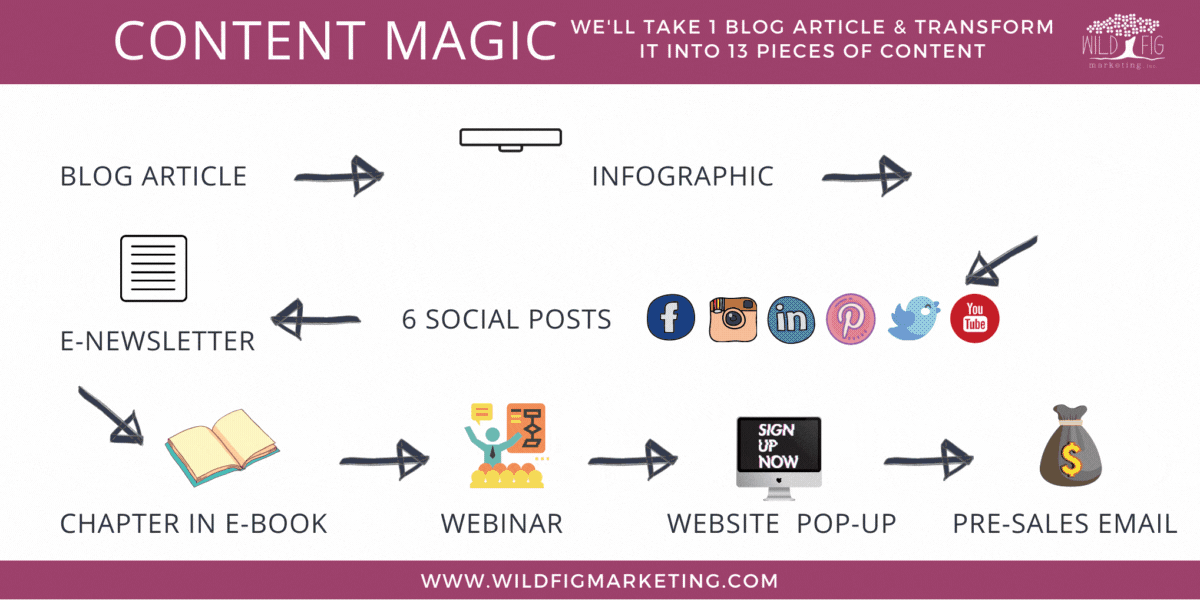How Often Should I Refresh the Content on My Website? [And Why Is It Important?]
If it's been a while since you made updates to your website...it might be time.
6 min read
 Allie Krueger
:
August 14, 2023
Allie Krueger
:
August 14, 2023

Content marketing is one of the most effective ways to promote products and services. But for many business owners, the stress of having to create new content all the time is overwhelming.
That’s where historical optimization and content repurposing comes in! Using these strategies, you can use content you already have to make something new. By refreshing and repurposing your old blogs, social media posts, and web copy, maintaining a consistent content marketing strategy can be much easier than you think.
Let’s take a look at how you can leverage both of these strategies to take the stress out of the content creation process.
In reference to blogging, historical optimization simply means to optimize — or make the best use of — a blog you’ve already written and published.
In order to “optimize” an old blog, you want to rework it in a few key ways to keep it fresh, up-to-date, and most importantly, increase its ability to generate traffic and conversions for your business.
Historical optimization should be a key part of your content strategy. That means it’s time to stop focusing solely on churning out new content, start getting more mileage out of the content you’ve already created!

There’s a short and a long answer to this question.
The short answer is this: Even though you’re blogging every month, chances are, you have a few key blogs that attract the most traffic to your website. Historical optimization lets you capitalize on those blogs and make them high-converting as well as high-traffic. Historical optimization also lets you take the underperforming blogs and improve them so they gain more traffic.
Now, here’s the long answer:
There are over 600 million blogs online, and because businesses all over the world are trying to capitalize on content marketing, you can expect that number to keep growing. But while there’s this massive growing supply of content out there, the demand for content has actually remained the same. So what does that mean for all these bloggers?

It means that the majority of their work isn’t being read. That means all that time and energy they put into their content isn’t generating returns to justify the effort. It means they’re wasting their time and money.
You don’t want to be one of these bloggers.
This is why it’s so important to use on-page SEO tactics, and to analyze data as a part of your larger content strategy. And historical optimization is just one of the ways you can analyze and put data to use. It will help you get the highest return for the time, energy, and money you spent on your blogs.

Identify high traffic but low-conversion blogs. These blogs aren’t generating many leads, but they sure get a lot of eyes on them! We’re going to rework the calls to action (CTAs) of these bogs to turn them into lead-generating machines for your business. Our goal is to increase your conversions.
Then, identify high conversion but low-traffic blogs. Our goal will be to increase the traffic to these blogs by improving their search engine optimization (SEO) so that Google sends more users your way.
But how to get this data? Well, ideally your blogging platform should provide you with data, like HubSpot’s Marketing Analytics & Dashboard Software. This particular software will provide you with an attribution report that can show you if the changes you’re making to your blogs are making a difference.
Check out your blogging platform and explore what analytics are available to you.
Identify which keywords are sending users to each popular blog. You can find this information using a combination of keyword research and a keyword tracking tool like HubSpot's or Mangools’.
Then, figure out the one or two keywords that the majority of each post's traffic seems to be coming from.
Yes, it’s that simple. For example, if a the keyword driving your blog traffic is “How To Move Across The USA”, then your CTA could look like this:
"If you’re ready to learn how to move across the USA, schedule a discovery call with [Name] Travel Agents today! "
Now that you’ve optimized the calls to action of your high performing blogs, it’s time to take a look at the blogs that aren’t performing so well. Google rewards freshness with better rankings, so you need to refresh that old content that isn’t getting enough traffic.
Here’s how to refresh old blog content:
Note: If you’ve had a blog for 3-5 years, you should aim to refresh old blog content at least once or twice a month. (If your blog is less than 2 years old, it’s probably going to be more beneficial for you to focus on writing new content for now. Put Historical Optimization in your back pocket for later!)

OK, so we’ve breathed new life into our old content – Now it’s time to transform it into something entirely different.
Repurposing your content is when you take content that you’ve already created in one medium, and use major elements of it again in another medium. This allows you to extend the value of your content by changing it to serve a different purpose.
An example of how to repurpose content would be to take several related blog posts and turn them into a guide; then turn the guide into an ebook; then turn the ebook into an educational video series. (And just think of all the social media posts!...)
Creating content consistently is key to a successful content strategy. But many businesses have trouble creating content on an ongoing basis. Repurposing your content helps fix this problem and more, by:
You may have heard of the marketing concept known as The Rule of 7: A prospect needs to see or hear your marketing message at least seven times before they take action and buy from you. Repurposing your content is one way to get your message in front of audiences again and again.

First, figure out which content forms you’re capable of creating. Content can appear in many forms, but here’s a list to start:
Which formats do you have the time and energy to create? (For example, you may not have the equipment to create a long form video, but a recorded webinar might be something you could look into instead.)
At this point, we’re assuming you’ve already chosen which pieces of content you want to repurpose (choosing high-performing content is a good idea). Take that content and break it down into modular pieces, so that you can use those pieces individually, or combine them with other things to make something totally new!
Modular pieces may include:
Now that you’ve broken down your content, look at the list in step one and brainstorm all the ways in which you could use those modular pieces to create brand new content in one of those mediums.
For example, maybe you could take your “tips & tricks” from your blog about pairing wines with fruits and cheese and turn it into monthly foodie newsletter content. Or maybe you could take your facts, statistics, and figures and create your own infographic.
Additionally, if you go through this process with multiple blogs, you could take modular elements from one blog and synthesize them with elements from another blog. This could create unique new content you never would have thought of before. To return to our wine pairing example, you could synthesize that with content from your “Why Wine is Good For Your Health” blog and create a “Healthy Wine & Food Pairings You Doctor Would Approve Of” social media series.
Every time you create a new piece of content, you need to be promoting it on different platforms. Write a new ebook? Record a podcast about it. Record a new podcast? Give it a shout-out in your newsletter. Write a new newsletter? Create a social media post to echo that content. And on and on it goes!

Brainstorming content ideas is the fun part (at least, we certainly think so!). We hope this post has your brain buzzing with new creative ways to optimize and reuse your old content.
But lots of our clients come to us because they need help creating said content. And luckily, that’s where we shine! If you’ve got a long-running blog that needs some new life breathed into it, let the pros at Wild Fig Marketing revamp your content strategy using historical optimization and content-repurposing techniques.
Schedule a 15 minute exploratory call today to tell us all your new ideas for your content, and we’ll tell you if we can help you reuse your old content and bring those ideas to life! Our marketing team is full of content creation experts who would be more than happy to help your blog get the attention it deserves. We look forward to working with you!

![How Often Should I Refresh the Content on My Website? [And Why Is It Important?]](https://www.wildfigmarketing.com/hubfs/bigstock-Technical-Support-Programming-460826949.jpg)
If it's been a while since you made updates to your website...it might be time.
![Pros and Cons of Using AI To Write Content [+ 5 Ways To Use It Effectively]](https://www.wildfigmarketing.com/hubfs/bigstock-System-Artificial-Intelligence-468896699.jpg)
Before you outsource all your content to ChatGPT, consider the pros and cons of using AI to generate digital content.

When it comes to content marketing, the competition is as fierce as ever. With more than 4.5 million blog posts generated each day, creating...